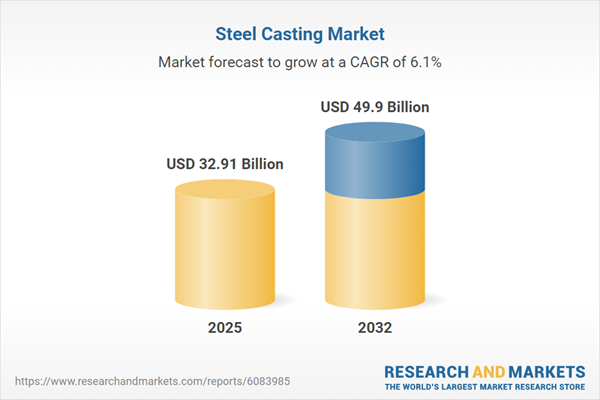Speak directly to the analyst to clarify any post sales queries you may have.
The steel casting market is advancing through innovation and strategic adjustments as manufacturers respond to new technology, regulatory requirements, and evolving supply chains. Insights in this report offer crucial guidance for executive leaders seeking clarity amid global manufacturing shifts.
Market Snapshot
The Steel Casting Market grew from USD 31.12 billion in 2024 to USD 32.91 billion in 2025. It is forecast to continue expanding at a CAGR of 6.07%, reaching USD 49.90 billion by 2032.
Growth is supported by strong demand from sectors including automotive, energy, aerospace, and infrastructure, alongside heightened requirements for complex geometries and advanced alloys. Digitalization and sustainable operation improvements are becoming ongoing drivers, while global shifts in industrialization and trade policy continue to shape the competitive landscape.Scope & Segmentation
This report provides comprehensive analysis and forecasting across the following:
- Material Types: Alloy steel castings, carbon steel castings, stainless steel castings, tool steel castings
- Production Processes: Centrifugal casting, die casting, sand casting, shell mold casting
- Applications: Aerospace & defense, automotive, food processing, heavy machinery, marine, oil & gas, power generation
- End Users: Aftermarket parts suppliers, defense contractors, industrial machinery manufacturers, infrastructure developers, OEMs
- Regions Covered: Americas (United States, Canada, Mexico, Brazil, Argentina, Chile, Colombia, Peru), Europe (United Kingdom, Germany, France, Russia, Italy, Spain, Netherlands, Sweden, Poland, Switzerland), Middle East (United Arab Emirates, Saudi Arabia, Qatar, Turkey, Israel), Africa (South Africa, Nigeria, Egypt, Kenya), Asia-Pacific (China, India, Japan, Australia, South Korea, Indonesia, Thailand, Malaysia, Singapore, Taiwan)
- Leading Companies: Ahresty Corporation, ArcelorMittal S.A., Bradken Ltd by Hitachi Construction Machinery Co. Limited, CALMET, Dawang Steel Casting Foundary, Dynacast International, Endurance Technologies Limited, Georg Fischer Ltd., Gujarat Precision Cast, Kobe Steel, Ltd., Mangal Iron, Matrix Metals, Metflow Cast, MINO Industry, Nippon Steel Corporation, Omnidex Group, Peekay Steel Castings, Precision Castparts Corp. by Berkshire Hathaway, Tata Steel Ltd., Thyssenkrupp AG, Uni Abex Alloy Products, Voestalpine AG, Waupaca Foundry Inc
Key Takeaways
- Complex casting requirements are pushing companies to embrace advanced manufacturing methods, such as simulation-driven designs and additive-assisted production, enhancing output precision and reducing rework.
- Sustainable operations remain a priority, with ongoing deployment of low-emission furnaces, circular recycling practices, and decarbonization initiatives aligning with tightening compliance policies globally.
- Supply chain resilience is being reinforced through near-shore production strategies, multi-sourcing, and establishment of regional hubs, aiming to reduce vulnerability to global disruptions and tariff fluctuations.
- Collaboration between foundries, OEMs, and R&D institutions is accelerating the development of lightweight alloys and hybrid manufacturing processes, driving innovation in end-use sectors such as mobility and energy.
- Market leaders are investing in digital integration, leveraging machine learning and real-time data analytics for predictive quality control and streamlined production.
Tariff Impact
Upcoming U.S. tariff adjustments present significant challenges to steel casting producers, particularly those sourcing key alloy inputs internationally. Manufacturers are evaluating alternative suppliers and boosting domestic sourcing to manage heightened costs. These shifts are also encouraging OEMs to consider new material strategies and manufacturing processes, influencing the competitive environment for both domestic and international players. Some market participants are investing in local or near-free-trade zone manufacturing to sustain market access and manage tariff-related risks.
Methodology & Data Sources
The research leverages a structured multi-stage approach, integrating extensive secondary data review with primary interviews across the steel casting value chain. Insights from industry leaders, technical specialists, and procurement experts are validated by quantitative modeling using global trade and production datasets. Scenario analysis and peer benchmarking enhance reliability and market relevance.
Why This Report Matters
- Enables senior decision-makers to benchmark their strategies against evolving digitalization, sustainability, and supply chain practices shaping the steel casting industry.
- Provides actionable insights for capital allocation, technology investment, and risk mitigation as trade and regulatory dynamics shift globally.
- Supports market entry and expansion planning by mapping segmentation trends, regional demand drivers, and profiles of market innovators and established players.
Conclusion
The steel casting market is being redefined by innovation, sustainability initiatives, and supply chain realignment. Executives equipped with these insights can proactively adapt strategies for operational excellence and future growth.
Table of Contents
3. Executive Summary
4. Market Overview
7. Cumulative Impact of Artificial Intelligence 2025
Companies Mentioned
The companies profiled in this Steel Casting market report include:- Ahresty Corporation
- ArcelorMittal S.A.
- Bradken Ltd by Hitachi Construction Machinery Co. Limited
- CALMET
- Dawang Steel Casting Foundary
- Dynacast International, Inc.
- Endurance Technologies Limited
- Georg Fischer Ltd.
- Gujarat Precision Cast Pvt. Ltd.
- Kobe Steel, Ltd.
- Mangal Iron Pvt. Ltd.
- Matrix Metals
- Metflow Cast Private Limited
- MINO Industry Co., Ltd.
- Nippon Steel Corporation
- Omnidex Group
- Peekay Steel Castings Pvt. Ltd.
- Precision Castparts Corp. by Berkshire Hathaway Inc.
- Tata Steel Ltd.
- Thyssenkrupp AG
- Uni Abex Alloy Products Ltd. by Neterwala group
- Voestalpine AG
- Waupaca Foundry Inc
Table Information
| Report Attribute | Details |
|---|---|
| No. of Pages | 190 |
| Published | November 2025 |
| Forecast Period | 2025 - 2032 |
| Estimated Market Value ( USD | $ 32.91 Billion |
| Forecasted Market Value ( USD | $ 49.9 Billion |
| Compound Annual Growth Rate | 6.0% |
| Regions Covered | Global |
| No. of Companies Mentioned | 24 |









